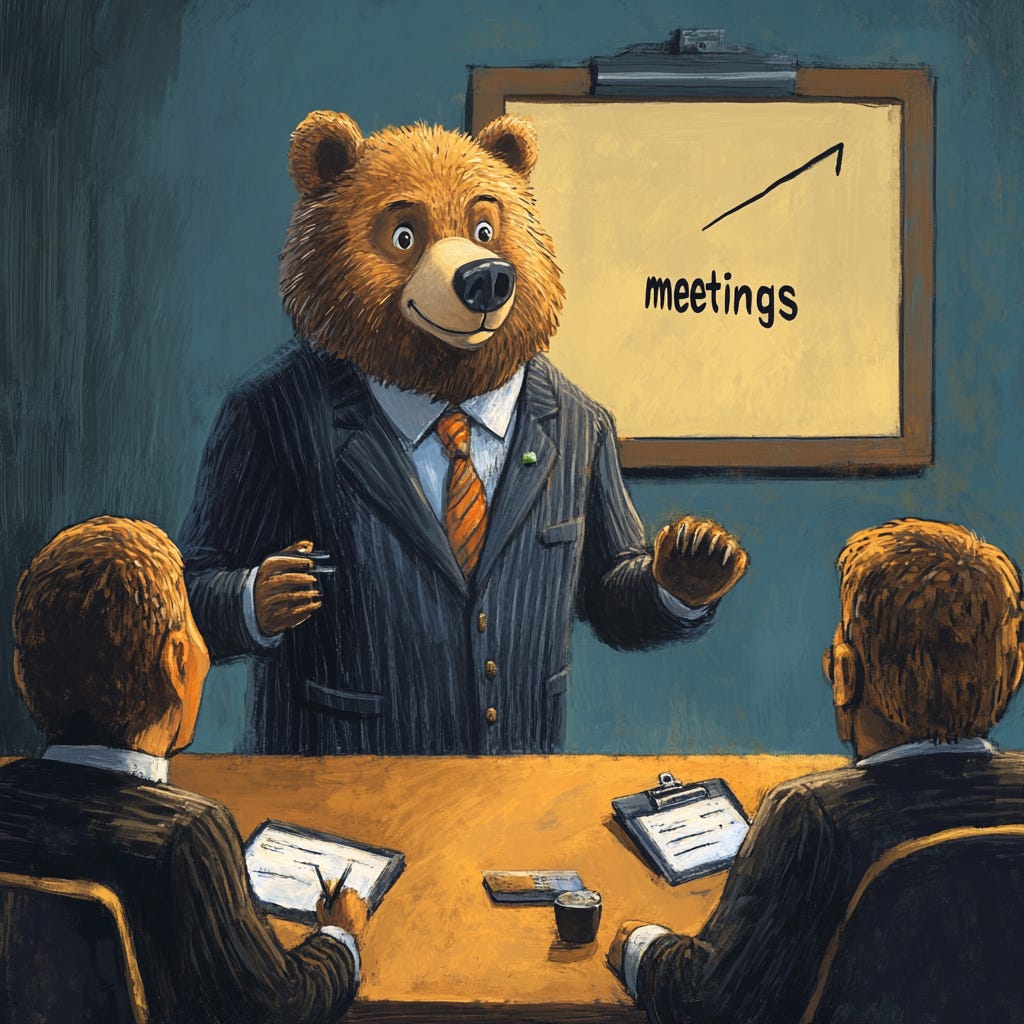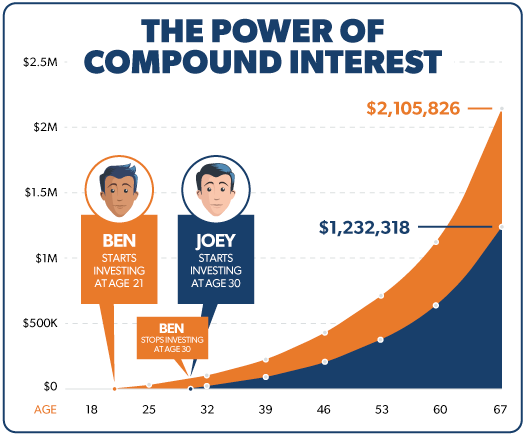The Economics of Cold Calling - Why Meetings Don't Matter (Part 4)
The Fat Stacks Are In The Circle Backs
Credit to Ryan Reisert for the idea of conversational advertising, on which this article is based
Intro
If I ask you what the purpose of cold calling is, what would be your answer?
This is one of the very first questions Justin Middleton would pose to us as new reps starting at Apex Revenue, and one that most of us, having inherited the myopic misconceptions of our previous sales leaders, got wrong.
Veteran GTM operators can probably guess what I’m going to say next. For the uninitiated, we will rip the band aid off:
The purpose of cold calling is NOT to book meetings.
It’s perhaps a tad inflammatory to say, as we did in the title here, that meetings “don’t matter” - after all, the logical continuation of any sales process does involve meetings occurring at some point - but it’s critical for meetings to only be set with prospects who have a high propensity to turn into legitimate opportunities.
Failure to do so and a hyperfocus around generating meetings for their own sake comes with a whole host of negative side effects and opportunity costs, including:
Brand reputation damage caused during conversations by reps pushing for meetings with prospects who aren’t ready to take next steps in the process
Meeting invitations accepted & sales resources mobilized for prospects with a low propensity to show up for said-meetings (because, you know, they didn’t want to take them in the first place)
The expensive and fruitless open loop of pursuing prospects who continually no-show or cancel
Meetings held for the sake of checking a box with prospects who have little to no motivation to play a part in solving the problems your organization specializes in
Because people struggle with conceptualizing opportunity and implicit costs, it can be easy to justify these meetings for their own sake. For sales leadership doing so is an easy way to check boxes and stave off questioning executives. After all, if meetings are happening (a “leading indicator!” they will attempt to sell you), then revenue is just around the corner (and therefore they should stay in seat for another quarter…) right?

“Be careful what you wish for” is a prescient warning here. Reps under pressure to book more meetings will do exactly that, baking further inefficiency into your acquisition channel and driving your cost of customer acquisition (CAC) up as a result.
Worse - diagnosing the root cause here becomes more difficult: Are prospects no showing because of something tactical occurring on the organizational side (expectations not being set properly on the initial call, meetings being booked too far out, not enough pre-meeting nurture) or because the prospect isn’t even in the buying window to begin with?
As they say, an ounce of prevention is worth a pound of cure, and a dash of nuance is all we need to lubricate the gears of this outbound machine. As a revision: We want to set meetings with prospects who are either ready to buy or open to buying - while making sure that prospects who are not are nurtured appropriately until such time that they are.
This begs the obvious question: How do we ensure our calling program is set up in such a way as to raise the probability of identifying where a prospective buyer is in the process and only suggesting prospects forward at such time that there’s mutual benefit in doing so?
It turns out the answer is a combination of (1) reclaiming a label that has become pejorative (2) counterintuitive thinking - and confront some limiting beliefs in doing so:
Telemarketing
When you hear the word “telemarketing”, what comes to mind?
For most of us, it’s sitting at the dinner table after school, getting ready to dig into our food when the house phone (remember those?) rings. Our mom or dad groans, getting up in an exasperated huff to answer the phone. “Hello?” You see their mouth set into a firm line at the realization that this is a stranger calling, with the audacity to be selling. “I’m sitting down to have dinner with my family. This isn’t a good time” the caller is on thin ice. You hear the other end of the phone continue to pile it on - pitch slap! Your mom/dad loses the remainder of their patience: “I said this isn’t a good time…I’m not interested!” They hang up the phone and come back to the table shaking their head “those damn telemarketers, I tell you…”
It’s my belief that this stigmatization of the term “telemarketing” has created a blind spot for sales leaders that prevents them from seeing the calling channel for what it really is: Using the telephone to deliver one to one conversational advertising widgets - aka - “telephone marketing”
Let’s dive in.
A Linguistic Perspective
If we break down the compound word “telemarketing”, we see that its constituent elements are the words “telephone” and “marketing”.
Viewed in this capacity, what we are doing is using the human voice as a mechanism to deliver a one to one, real-time personalized advertisement - not unlike an ad in any other medium.
The amount of data compressed into a one to one conversation, however, confers considerable benefits over more traditional advertising methods. Let’s compare them:
Conversational vs. Traditional Advertising - A Comparison
1. Paid Ads Data Points
When you run a paid ad, you typically get:
Impressions: Number of times the ad was shown.
Clicks: Number of times the ad was clicked.
Click-Through Rate (CTR): Ratio of clicks to impressions.
Conversions: Actions taken post-click (purchases, sign-ups).
Engagement Metrics: Time on site, pages visited, etc.
Limitation:
If a user doesn’t engage (e.g., no clicks), the only data you have is an impression count, which reveals very little about why they didn’t engage or who they are.
Binary - regardless of outcome (i.e: Whether somebody clicks or not) even if somebody clicks, the “why” they click
2. Cold Calling Data Points
Compared to a passive ad widget, a live time conversation yields significantly more granular and actionable data:
Qualitative Data:
Initial reaction to the pitch (tone, hesitancy, interest).
Explicit feedback or objections (“We don’t deal with that,” “We already have a solution,” etc.).
Insights into needs or pain points.
Quantitative Data:
Call duration.
Number of touchpoints required before a conversation occurs.
Derived Data:
Persona insights (role, authority level).
Competitive intelligence (what alternatives they’re using).
Timing insights (is this a need now or later?).
Your Cold List - Getting A Baseline
With the previous context in mind, let’s talk about what we’re trying to determine on the first touch to our cold list:
Reach and receptivity
How much of your audience can you reach via the phone?
How much of your audience, once reached, is receptive to hearing a message delivered in this medium?
Messaging baseline - how much does your messaging resonate?
Does the message resonate more with some titles than others?
Is there a common thread running through the objections?
Timing - if the message resonates, is this something immediately relevant?
If not, is there a pattern as to when the topic DOES become relevant?
You’ll notice that this list is entirely devoid of the demands for meetings that are typical of what most sales leaders expect from an initial touch point, instead taking the long view of generating brand awareness and segmenting your audience for the next best steps.
RE: Messaging - think of every infomercial you’ve ever seen. What’s the lead? A problem. Benefit from the hundreds of millions of dollars in consumer research that’s determined the following: It’s easier to object to solutions than it is to object to problems. At the end of the day the purpose of your product or service is to solve a problem, and so the most crucial thing to determine is whether or not your audience has a problem you can solve.
Some examples here:
“Nowhere to run? Nowhere to ride?”“Does the shoulder strap in your car cut into your shoulder?”
“For over 100 years, we’ve been scrunching and folding toilet paper”
“You want to stay covered after being wet, but your towel just won’t let you”
There’s also a logical progression to starting with the problem: If the problem doesn’t resonate, your solution is moot - but if the problem does resonate then not only have you demonstrated relevance (meaning your audience will actually pay attention to your proposed solution), but it then becomes logically continuous to explore a solution.
Alas, there are plenty of reasons somebody may not act or evaluate a solution. Rather than doing what most reps do and push for a meeting anyway, seek to understand the objection. This is distinct from seeking to overcome the objection. Unlike the average rep, the GTM Operator understands that the “fat stacks are in the circle backs”, and the more intel can be gathered here, the more specific and personalized a follow-up (read: retargeting…) ad we can deliver.
Now that you’ve segmented your audience for appropriate retargeting, you can go to the next step: Circling back to your follow up list and engaging accordingly.
Follow Ups
If we return to the paid ads analogy, performance marketers have a dazzling array of re-targeting campaigns: Behavioral retargeting, dynamic retargeting, platform-specific retargeting etc.
The list goes on and on, with improved outcomes expected at each stage of re-targeting, and yet 99% of cold callers will take the first “not interested” as license to never call back again.
It bears repeating that your follow ups will convert at a much higher rate than your cold leads, which means that failure to follow up on them means you are neglecting the highest expected return activities in your funnel.
Let’s take a page out of the performance marketer’s playbook and look at some of the buckets we want to personalize our subsequent outreach to:
Yes (but send me more information before I'll book a meeting): These are your activated leads. Having already self-qualified and opted in to learn more, these prospects should convert at the highest rate into next step meetings. Amusingly, most of the people you talk to here will not read the email you had sent, but following through with their initial request builds credibility and familiarity, which for these prospects is a prerequisite prior to taking next steps. Fulfill these steps and you will find them more amenable to a progression in your relationship.
Not Now: Timing - original message resonated, circle back and reference timing - patience is a virtue here. Assuming you bucketed correctly - answering the question “if not now, then when?” - follow ups become a question of leveraging the original context of the conversation. Paraphrased: “When we last spoke, you mentioned X…I was calling back to see if you had a minute to chat and see if a further conversation might be more relevant for you at this stage”
Not Interested: Original message did NOT resonate, circle back with a new offer - again, leverage the context of the original discussion. This is not your blow-off “Not Interested” where the person hears your company name and then hangs up, but rather a list of folks with documented feedback on why your initial cold offer did not resonate with them. Data analysis of a representative sample size (call it 50 conversations) is key here: If 50 people tell you they’re not interested for the same reason, can you tweak something in your messaging or offer to make it more enticing?
Call Back (Busy): These are folks that vocalized that they were in the middle of something and as a result not able to talk. Depending on how far you got into the conversation and how long it’s been since you’ve spoken, you can simply pick back up where you left off OR start with your cold pitch to subsequently bucket them into the appropriate category.
Call Back (Hang): For this bucket, all we are trying to do is determine channel receptivity. There is a non-trivial percentage of the population that will simply hang up as soon as they identify they’re talking to a sales person, no matter how good you are. You will not change their minds, so rip the band aid off and figure this out and send them to marketing for nurture.
Becoming Inevitable
A clear trend should have emerged for those paying attention: The longer you’re “in seat”, the more prospects you’re able to move from your cold list into the appropriate re-targeting buckets, and the higher probability of success you’ll see with subsequent respectful persistence.
Over time, you’ll hit an inflection point where the majority of conversations you have will be follow ups, which dramatically improves the expected value of your prospecting efforts over time.
This perspective is how effective sales programs are built, even if it’s an anathema to the “meetings right now” leadership crowd pandering to impatient, clueless investors.
Need help building this for your team? Shoot me an email at charles@needham.co and I’ll get you sorted.







Charles, what do you recommend as a strategy for activated leads vs just nurturing? Is it just following up faster?
🤯